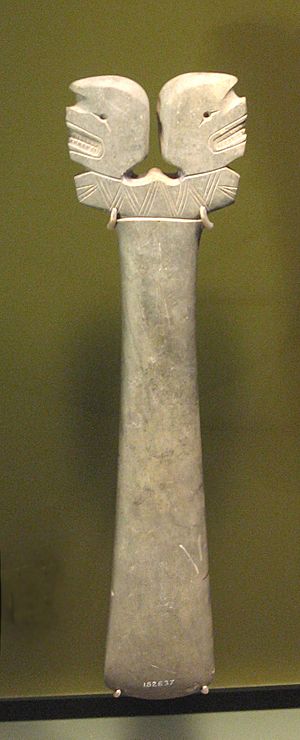Greenstone (archaeology) facts for kids
Greenstone is a general name for many valuable green rocks and minerals. Ancient cultures used these stones to make beautiful objects. They carved jewelry, small statues, special tools for ceremonies, and other important items.
Greenstone can be made of different minerals. Some common ones include serpentine, nephrite, and jadeite. The term "greenstone" also includes jade. These rocks get their green color from minerals like chlorite or epidote.
Contents
What is Greenstone?
People in ancient times likely chose greenstone because of its beautiful color. They often used different types of green stone as if they were the same. This is why archaeologists use one general term, "greenstone."
Greenstone objects are often found far from where the stone originally came from. This shows that ancient people traveled or traded over long distances. For example, a polished jadeite axe head found in England was made from stone from the Alps in Italy. This means the stone traveled a very long way!
Greenstone Around the World
Greenstone was very important in many ancient cultures.
Ancient China and Mesoamerica
Ancient China and Mesoamerica are famous for using greenstone, especially jade. They made many important and beautiful objects from it.
Australia and New Zealand
Greenstones were also very important to the native cultures of southeastern Australia. The Māori of New Zealand also valued greenstone. They called it pounamu.
Europe and Other Cultures
In Neolithic Europe, greenstone was used to make special axe tools. These axes were not for everyday use. They were likely symbols of power or status. Similar jade tools and weapons were also found in the Olmec culture and other Pre-Columbian cultures. Early Chinese civilizations also used greenstone in this way.
Gallery of Greenstone Tools and Weapons
-
This greenstone ceremonial axe is from Tobago.
See also
 In Spanish: Roca verde para niños
In Spanish: Roca verde para niños






